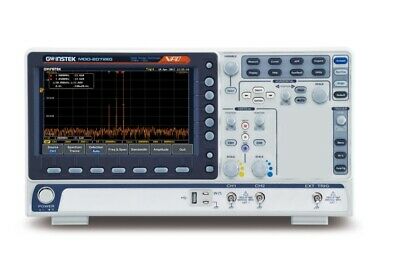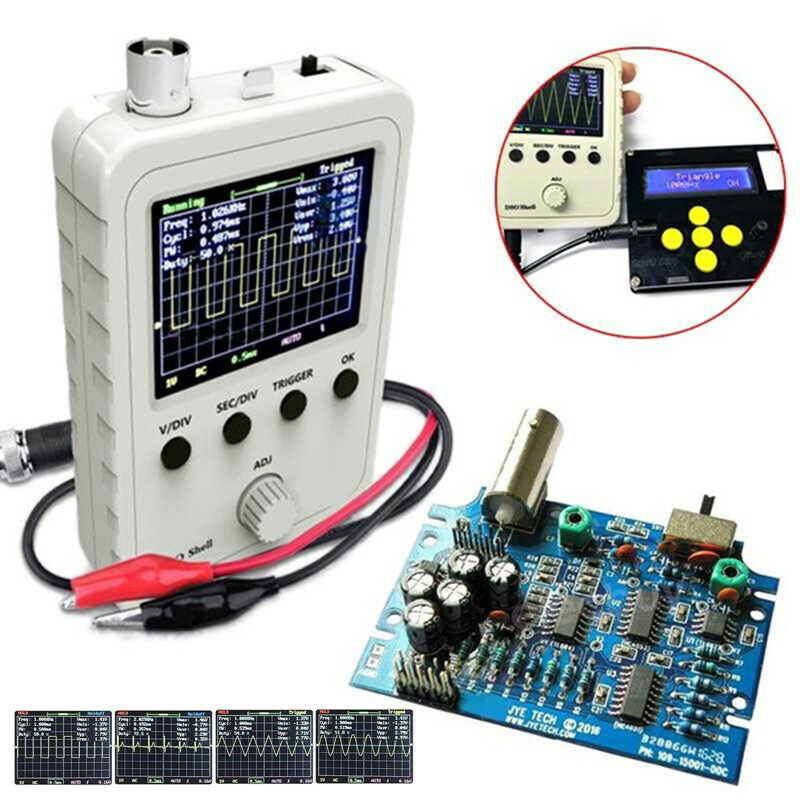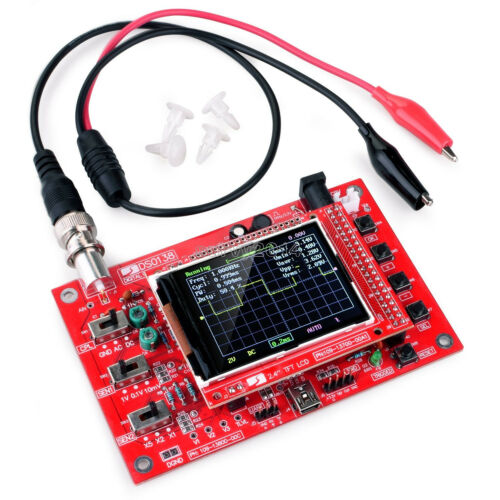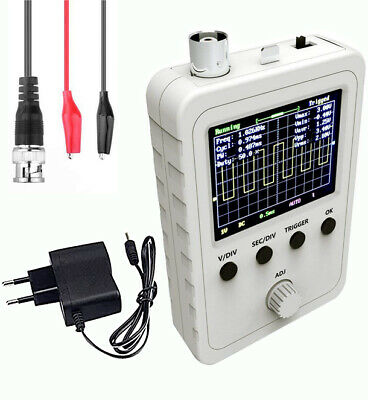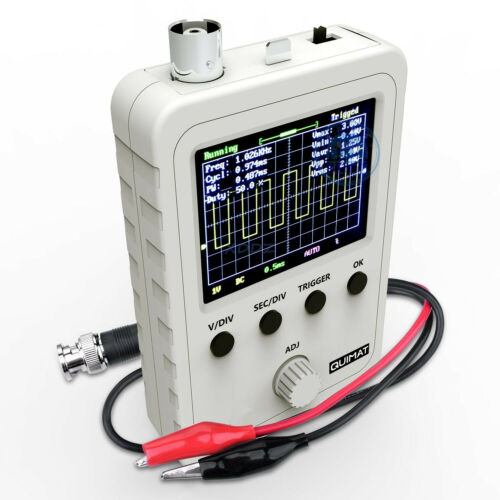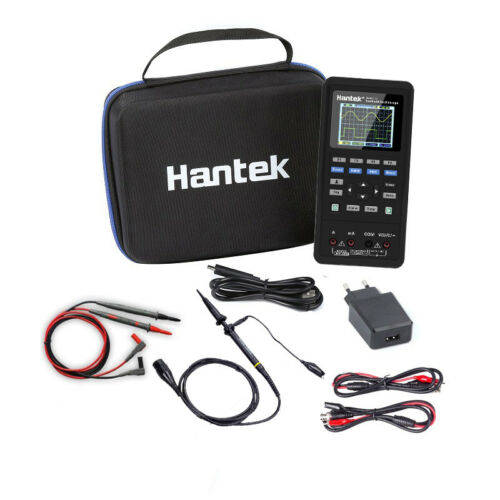-40%
Instek MDO-2072EG Mixed Domain Oscilloscope NEW
$ 415.32
- Description
- Size Guide
Description
Features:Spectrum Analyzer; Dual Channel 25MHz Arbitrary Waveform Generator
Real time sample rate for each channel is 1GSa/s (2 channel models)
Maximum real time sample rate is 1GSa/s (4 channel models)
Per Channel 10M memory depth and VPO waveform display technology
Waveform update rate up to 120,000 wfms/s
8" WVGA TFT LCD display
Free Frequency Response Analyzer Software
Maximum 1M FFT provides higher frequency domain resolution measurements
High, low and band pass filter functions
29,000 segmented memories and waveform search functions
I²C/SPI/UART/CAN/LIN serial bus trigger and decoding function
Data log function is able to track signal changes up to 1000 hours
Network storage function
Mask test function
Three-year warranty, excluding probes & LCD display panel
Specifications
Vertical Sensitivity
Channels: 2 + EXT
Bandwidth: DC~70MHz(-3dB)
Rise Time: 5ns
Bandwidth Limit: 20 MHz
Vertical Resolution: 8 bit: 1mV~10V/div
Input Coupling: AC, DC, GND
Input Impedance: 1MΩ//16pF approx.
DC Gain Accuracy: ± (3%)when 2mV/div or greater is selected; ±(5%)when 1mV/div is selected
Polarity: Normal & Invert
Maximum Input Voltage: 300Vrms, CAT I
Offset Position Range: 1mV/div ~ 20mV/div: ±0.5V; 50mV/div ~ 200mV/div: ±5V; 500mV/div ~ 2V/div: ±25V; 5V~10V/div: ±250V
Waveform Signal Process: +, -, ×, ÷, FFT, User Defined Expression.
FFT: 1Mpts
FFT: Spectral magnitude. Set FFT Vertical Scale to Linear RMS or dBV RMS, and FFT Window to Rectangular, Hamming, Hanning, or Blackman.
Trigger
Source: Ch1, CH2, CH3, CH4, Line, EXT*; *dual channel models only
Trigger Mode: Auto (Supports Roll Mode for 100 ms/div and slower), Normal, Single Sequence
Trigger Type: Edge, Pulse Width (Glitch), Video, Pulse Runt, Rise & Fall (Slope), Alternate, Time out, Event-Delay (1~65,535 events), Time-Delay (Duration; 4ns~10s), Bus
Trigger Holdoff Range: 4ns ~ 10s
Coupling: AC, DC, LF rej., Hf rej., Noise rej.
Sensitivity: 1div
Ext Trigger
Range: ±15V
Sensitivity: DC ~ 100MHz Approx. 100mV; 100MHz ~ 200MHz Approx. 150mV
Input Impedance: 1MΩ±3%, ~16pF
Horizontal
Time Base Range: 1ns/div ~ 100s/div (1-2-5 increments); ROLL: 100ms/div ~ 100s/div
Pre-trigger: 10 div maximum
Post-trigger: 2,000,000 div maximum
Time Base Accuracy: ±50 ppm over any ≥1 ms time interval
Real Time Sample Rate: Max.: 1GSa/s (4ch model); Per channel 1GSa/s (2ch model)
Record Length: 10Mpts/CH
Acquisition Mode: Normal, Average, Peak Detect, Single
Peak Detection: 2ns (typical)
Average: Selectable from 2 to 256
X-Y MODE
X-Axis Input: Channel 1; Channel 3* (*: four channel models only)
Y-Axis Input: Channel 2; Channel 4* (*: four channel models only)
Phase Shift: ±3° at 100kHz
Cursors and Measurement
Cursors: Amplitude, Time, Gating Available; Unit: Seconds(S), Hz(1/S), Phase (Degrees), Ratio(%)
Automatic Measurement: 38 sets: Pk-Pk, Max, Min, Amplitude, High, Low, Mean, Cycle Mean, RMS, Cycle RMS, Area, Cycle Area, ROVShoot, FOVShoot, RPREShoot, FPREShoot, Frequency, Period, RiseTime, FallTime, +Width, -Width, Duty Cycle, +Pulses, -Pulses, +Edges, -Edges, %Flicker, Flicker Idx., FRR, FRF, FFR, FFF, LRR, LRF, LFR, LFF, Phase
Control Panel Function
Auto Counter: 6 digits, range from 2Hz minimum to the rated bandwidth
Autoset: Single-button, automatic setup of all channels for vertical, horizontal and trigger systems, with undo Autoset
Save Setup: 20 sets
Save Waveform: 24 sets
Display System
TFT LCD Type: 8" TFT LCD WVGA color display
Display Resolution: 800 horizontal x 480 vertical pixels (WVGA)
Interpolation: Sin(x)/x
Waveform Display: Dots, Vectors, Variable persistence(16ms~4s), Infinite persistence
Waveform Update Rate: 120,000 waveforms per second, maximum
Display Graticule: YT; XY
Display mode: 8 x 10 divisions
Interface
USB Port: USB 2.0 High-speed host port x 1, USB 2.0 High-speed device port x 1
Ethernet Port (LAN): RJ-45 connector, 10/100Mbps with HP Auto-MDIX
Go/NoGo BNC: 5V Max/10mA TTL open collector output
Kensington Style Lock: Rear-panel security slot connects to standard Kensington-style lock
Spectrum Analyzer Specifications
Frequency Range: DC~500MHz(Max.) (Max. bandwidth ~500MHz uncalibrated)
Span: 1kHz ~ 500MHz(Max.)
Resolution Bandwidth: 1Hz ~ 500kHz(Max.)
Reference Level: -50 dBm to +40dBm in steps of 5dBm
Vertical Units: dBV RMS; Linear RMS; dBm
Vertical Position: -12divs to +12divs
Vertical Scale: 1dB/div to 20dB/div in a 1-2-5 Sequence
Display Average Noise Level: 1V/div < -50dBm, Avg: 16; 100mV/div < -70dBm, Avg: 16; 10mV/div < -90dBm, Avg: 16
Spurious Response: 2nd harmonic distortion< 40dBc; 3rd harmonic distortion< 45dBc
Frequency Domain Trace Types: Normal; Max Hold; Min Hold; Average (2 ~ 256)
Detection Methods: Sample; +Peak; -Peak; Average
FFT Windows: FFT Factor: Hanning 1.44; Rectangular 0.89; Hamming 1.30; Blackman 1.68
AWG Specifications
Channels: 2
Sample Rate: 200 Msa/s
Vertical Resolution: 200 Msa/s
Max. Frequency: 25 MHz
Waveforms: Sine, Square, Pulse, Ramp, DC, Noise, Sinc, Gaston, Lorentz, Exponential Rise, Exponential Fall, Haversine, Cardiac
Output Range: 20 mVpp to 5 Vpp, HighZ;10 mVpp to 2.5 Vpp, 50Ω
Output Resolution: 1mV
Output Accuracy: 2% (1 kHz)
Offset Range: ±2.5 V, HighZ; ±1.25 V, 50Ω
Offset Resolution: 1mV
Sine: Frequency Range:100mHz~25MHz; Flatness: ±0.5 dB (relative to 1kHz); Harmonic Distortion: -40 dBc; Stray (Non-harmonic): -40 dBc Total Harmonic Distortion: 1%; S/N Ratio:40 dB
Square/Pulse: Frequency Range: 100mHz~15MHz; Rise/Fall time: <15ns; Overshoot: <3%; Duty cycle Square: 50% & Pulse:0.4%~99.6%; Min. Pulse Width: 30 ns; Jitter:500 ps
Ramp: Frequency Range: 100mHz~1MHz; Linearity: 1%; Symmetry: 0~100%
Frequency Response Analysis
Dynamic Range: > 80 dB (typical)
Input and Output Sources: Channel 1 or 2 (3 or 4 for four channel model)
Frequency Range: 20 Hz to 25 MHz
Number of Test Points: 10 to 90 points per decade
Test Amplitude: 20 mVpp to 5 Vpp into High-Z Fixed amplitude across entire sweep
Test Results: Logarithmic overlaid gain and phase plot
Manual Measurements: Two pairs of tracking gain and phase markers
Plot Scaling: Auto-scaled during test
Power Source Miscellaneous
Line Voltage Range: AC 100V ~ 240V, 48Hz ~ 63Hz, auto selection
Multi-Language Menu: Available
On-Line Help: Available
Time Clock: Time and date, provide the date/time for saved data
Operation Environment: Temperature: 0°C to 50°C. Relative Humidity: ≤80% at 40°C or below; ≤45%, 41°C ~ 50°C
Dimensions: 384mm X 208mm X 127.3mm
Accessories: Power Cord, Certificate of Calibration, CD-ROM (with Quick Start Guide, User Manual, Programming Manual), Passive probe (one probe per channel)
GTL-110: BNC-BNC cable
The Instek MDO-2000E series is multi-functional mixed domain oscilloscope. The series includes two feature combinations: MDO-2000EG and MDO-2000EX. MDO-2000EG models have a built-in spectrum analyzer and a dual channel 25MHz arbitrary waveform generator and MDO-2000EX models feature a built-in a spectrum analyzer, arbitrary waveform generator, a 5,000 count DMM, and a 5V/1A power supply. The first of its kind, MDO-2000EX is the only oscilloscope to equip with a DMM and a power supply in the T&M industry.
While entering the spectrum mode, MDO-2000E series will display a full screen of frequency domain. Users can input Center frequency, Span, Start frequency, and Stop frequency based upon test requirements so as to rapidly and intuitively observe required frequency range that allows users to experience the user interface of a real spectrum analyzer. While observing frequency domain display, engineers can observe waveform characteristics, which are not easily to be seen from time domain waveforms, for instance, the harmonic composition of a waveform and the frequency characteristics of a modulation signal. Compared with oscilloscope' FFT, MDO-2000E series allows engineers to effectively conduct signal measurements on frequency domain.
Conventional DSO's FFT always calculates the entire signal bandwidth up to half the sampling rate (Fs). However, the insufficient calculation capability can't conduct FFT calculation with more points. Users can't have the signal's detailed frequency information due to the insufficient frequency resolution from the calculation result. Whereas MDO-2000E series analyzes signal spectrum of interest. Compared with oscilloscope FFT, MDO-2000E series allows engineers to effectively conduct signal measurements on frequency domain.
MDO-2000E series frequency domain also includes Spectrum Trace Type settings (Normal, Max-hold, Min-hold, and Average). Users can freely select various Spectrum Traces for simultaneous display. Detection method (Sample, +Peak, -Peak, and Average) can be individually set for each Trace. Additionally, users, via Cursor, can manually mark the corresponding positions to reflect Frequency and Amplitude. The Search function can also be applied to log spectrum's Peak Table. Amplitude is displayed with dB and Marker can obtain measurement data. Users can use the Search function to search and mark the amplitude and frequency of spectrum signal. Search methods include Max. peak and threshold. Measurement results can be displayed and saved.
Compared with the general spectrum analyzer, the spectrum function of MDO-2000E series can test below~9kHz signals, which is applicable to the frequency domain analysis of audio frequency and vibration. MDO-2000E series can also test the frequency domain signal with DC component without damaging the instrument. With respect to frequency domain waveform display, MDO-2000E series, featuring the same capability of a real-time spectrum analyzer, is faster than the general spectrum analyzer. Why? It is because MDO- 2000E series utilizes digital circuit and software to calculate FFT. The general spectrum analyzer can only process the signal of a narrow frequency bandwidth at a time by frequency sweeping. Each sweeping will take several ms to dozens of ms. Hundreds and thousands of frequency sweepings are gathered to form a spectrum. Therefore, the displayed spectrum is not obtained at the same time. MDO-2000E series obtains spectrum display at the same time by utilizing digital circuit and software to calculate FFT that is faster than the frequency sweeping method. The FFT settings of oscilloscopes are based upon horizontal scale (sample rate) setting, which is totally different from the frequency range setting of MDO-2000E series. Most instruments will have insufficient frequency resolution due to insufficient FFT points while conducting spectrum measurement by FFT. Compared with the FFT of oscilloscopes, MDO-2000E series satisfies users with signal measurement requirements under 9kHz; a better setting interface, measurement resolution and measurements speed.
Three screen displays on the right show the spectrum results of MDO-2000E's spectrum analyzer and the FFT of two different branded oscilloscopes after testing the same FSK signal. The parameters of FSK signal: 500mVpp sine wave, fmax: 10.2MHz, fmin: 10.0MHz, bit rate: 10.0kHz. The upper right screen display is the spectrum of MDO-2000E's spectrum analyzer. Users can directly input Center and Span Frequency by an intuitive and swift setting. Fmax and fmin can be clearly identified from the screen display.
The right screen display is an often seen spectrum from a general oscilloscope's FFT. The left boundary started from DC (low frequency signal) and the maximum frequency on the right is half of the sample rate (can be extended to the right or even out of the boundary). The Span setting for spectrum can only be switched by fixed 1-2-5 multiplying factors. Therefore, users can't set Span according to their requirements that is extremely inconvenient for the operation. In fact, switching multiplying factor is to conduct Zoom In/Out calculation on the original FFT spectrum and the sample rate remains the same during the calculation process. Users can easily encounter the upper and lower boundary limits that is totally different from the general spectrum analyzer in terms of operational experience. Most importantly, no matter how setting is changed the important fmax and fmin of spectrum can't be identified.
The right screen display is the FFT spectrum from a well-known oscilloscope manufacturer. It also provides Span setting (adjustable 1-2-5 multiplying factor) but the result is the same as the previous case, which only conducts Zoom In/Out calculation on FFT spectrum and FFT calculation points have not increased. This method is absolutely unhelpful on increasing frequency resolution. Therefore, its fmax and fmin can't be identified as well.
Users will see fmax and fmin appearing on the screen alternatively if the conventional swept tuned spectrum analyzer is used to conduct the measurement on the previous signal. The reason is that each frequency component is not obtained at the same time frame and it will take a longer time to process.
MDO-2000E also provide the frequency response analysis function (Bode plot). The FRA software can be directly downloaded from GW Instek website. Via arbitrary waveform generator, oscilloscope, and FRA software, users can obtain DUT's FRA characteristic curve plot. FRA has a very wide application range, including product circuit and component performance verification and analysis such as Feedback of Circuit Design, Filter Design, Amplifier Design, Resonant Circuit Design, Cable Frequency Response, and Signal Transformer Performance. Via FRA, users can preliminarily verify product and analyze component's characteristics without the expensive instrument.
The frequency range of FRA is from 20Hz to 25MHz; the number of test point can be selected from 10 to 90 points per decade. After completing the Bode plot, users can select measurement curve by Cursor so as to retrieve each point's amplitude and phase on the curve.
Other than the new functionalities, the hardware characteristics of MDO-2000EG and MDO-2000EX are identical to those of GDS-2000E Series. MDO-2000EG and MDO-2000EX are equipped with 8-inch display and feature bandwidth selections of 200MHz, 100MHz, and 70MHz. Models with two analog channels provide 1GSa/s real-time sampling rate per channel; models with four analog channels provide 1GSa/s maximum real-time sampling rate. The waveform update rate of 120,000 wfm/s and the minimum 1mV/div vertical range allow MDO-2000EG series MDO-2000EX to measure complex feeble signals and clearly display measurement results. With respect to the memory depth, MDO-2000E series provide 10M long memory for users to completely retrieve and analyze waveforms.
Users, based upon the application requirements, can select 1k, 10k, 100k, 1M or 10M memory depth. The segmented memory can be divided the maximum into 29,000 sections for users to bypass any unimportant waveforms so as to swiftly search all required waveforms. With the function, more meaningful waveforms can be saved and target waveforms can be displayed rapidly. With the waveform search function, users can rapidly search desired waveforms according to the required trigger conditions. MDO-2000E series also provides 1M FFT display that allows users to correctly and efficiently acquire measurement results of the frequency domain. MDO-2000E series, enhancing by the high waveform update rate of 120,000wfm/sec, Window Zoom and Peak Search, becomes the optimal choice of the economical and multi-function mixed domain oscilloscope.
120,000wfm/s Waveform Update Rate and VPO Waveform Display Technology
The MDO-2000E series oscilloscope allows users to easily and completely observe inrush signals and rare transient waveforms to increase waveform debugging efficiency by using features, including advanced VPO (Visual Persistence Oscilloscope) signal processing technology, waveform update rate as high as 120,000 wfm/s, and multi-layered afterglow display to enhance waveform display efficiency. Oscilloscope with VPO technology displays signals with three dimensional waveforms constructed by amplitude, time and signal strength to show each waveform point. 256 color gradients yield clear waveform changes. Comparing with the conventional digital storage oscilloscope, the MDO-2000E series provides more natural and more genuine signal display effect which is very close to the original analog signal.
Support I²C, SPI, UART, CAN, LIN BUS Trigger and Decoding Functions
The serial bus technology has been widely applied in the present embedded application design. The IoT devices connecting sensors and the peripheral components are using serial bus such as UART, I²C, and SPI. To rapidly and correctly trigger and analyze serial bus 2 data has posed a difficult challenge to engineers. The MDO-2000E series provides serial bus analysis function with 10M long memory depth. Users can trigger, decode, and analyze frequently used I²C, SPI and UART serial bus and CAN/LIN bus, which is often used by automotive communications.
Waveform Search Function
Users can rapidly search desired waveforms according to the trigger condition. After activating the search function, hollow inverted triangles will show the location met the trigger condition. The upper left hand corner Overall will show the total number of waveforms met the trigger condition. Users can set waveform search by the trigger condition such as Edge, pulse width, Runt, Rise/Fall, and Bus. When the trigger condition is met, hollow inverted triangles will appear. Users can save all marks to compare with the next input signal. The front panel of the MDO-2000E series controls waveform zoom-out and play/pause function to swiftly identify each desired event. The function allows users to conveniently complete waveform search and save marks for rapid comparison and analysis.
Data Log Function
Users, via the data log function, can observe waveform changes in long periods of time to ensure product reliability or measure sporadically appeared signals. The data log function, based on the requirements, can set record time and interval. Record time can be selected from 5 minutes to 1000 hours, and record interval is 5 seconds, the minimum. Waveform type for record data and CSV file format for each channel can also be selected. Data can be stored in USB drive, the MDO-2000E series or the remote computer via LAN.
Segmented Memory Function
Users Can Select “Analyze Segments” to Conveniently Obtain The Analysis Results
To achieve the most ideal application for memory depth, the MDO-2000E series has the built-in segmented memory function. The segmented memory function allows users to select the desired important signals for observation. Hence, insignificant signals can be neglected and serial bus decoding; pulse or inrush signals can be identified when retrieving signals. The segmented memory function of the MDO-2000E series allows users to select the number of sections. The maximum sections can be selected are 29,000. After activating the function, users can select and observe waveform for each segment by turning the Variable knob. The ultimate application of memory depth, therefore, is completely realized.
Mask Function
The MDO-2000E series provides the Mask function, which allows users to apply Auto Mask and user-defined Mask to determine whether the quality of the product meets the regulation. Via userdefined mask, users can set up to 8 areas and each area is up to 10 points to meet test requirements. Users can also refer to the examples from user manual to edit Mask by the PC to satisfy all test needs. By setting Save On, users can log and monitor signals, which violate test conditions.
25MHz Dual Channel Arbitrary Waveform Generator
The MDO-2000E series provides the Mask function, which allows users to apply Auto Mask and user-defined Mask to determine whether the quality of the product meets the regulation. Via userdefined mask, users can set up to 8 areas and each area is up to 10 points to meet test requirements. Users can also refer to the examples from user manual to edit Mask by the PC to satisfy all test needs. By setting Save On, users can log and monitor signals, which violate test conditions.
GUARANTEED QUALITY
Payment Terms
We accept payment prior to shipping
Domestic
:
Payment methods accepted:
PayPal - Preferred
Illinois buyers pay appropriate sales tax based on county (Please contact ValueTronics before making payment).
International
:
Payment methods accepted:
PayPal
All international buyers must request an invoice via email from ValueTronics to include shipping costs before finalizing purchase.
Return Policy
ValueTronics honors the buyer’s right of refusal for 14 days from receipt.
Buyer pays return shipping/packaging of all returns (Domestic and International).
Refund is credited to buyer’s account upon verification of unit’s condition.
Returns must be shipped with all original accessories. We will not accept any items with obvious signs of additional wear and tear or internal component alterations. All of our items will ship with “Warranty Void” tamper resistant stickers. If any stickers have been removed or tampered with your refund will be cancelled.
If you need to return your purchase please contact ValueTronics for a RMA.
Shipping & Handling
Domestic:
Varies by listing
(Includes Insurance)
All buyers in the continental United States pay a flat rate or determined rate for larger items. Contact us for freight charges where not listed. Insurance is mandatory and included on all shipments.Other shipping methods are available at the request and expense of the buyer.
International:
Buyer pays all shipping costs.
Buyer must request invoice that includes shipping costs before finalizing sale on eBay.
Shipping insurance is mandatory on all overseas orders.Your phone number is required for shipping purposes so please provide your phone number with all correspondence.
Estimated Delivery
: We can usually ship orders within 5 business days of payment receipt. If we can not meet this expectation you will be promptly notified. Many items can be shipped same day. Contact us for more information.
Shipping
: All items are professionally packed to arrive undamaged. If a purchase is received in damaged condition, you must immediately file a claim with the freight carrier and report the same to us. All packaging materials must be saved for inspection by the carrier representatives.
Feedback
We pride ourselves on exceptional customer service. With 28 years experience in the industry we proudly extend that expertise to our customers.We respond quickly to all comments and concerns with urgency and professionalism.
We ask that if you have any problems with your purchase, please try to resolve it with us directly before leaving us a
Neutral
or
Negative
rating on eBay. We have built a sterling reputation based on highly satisfied customers.
If you do leave us negative feedback before attempting to resolve the problem with us directly, we reserve the right to deem that as final resolution to that matter and will not accept a return or issue a refund.
